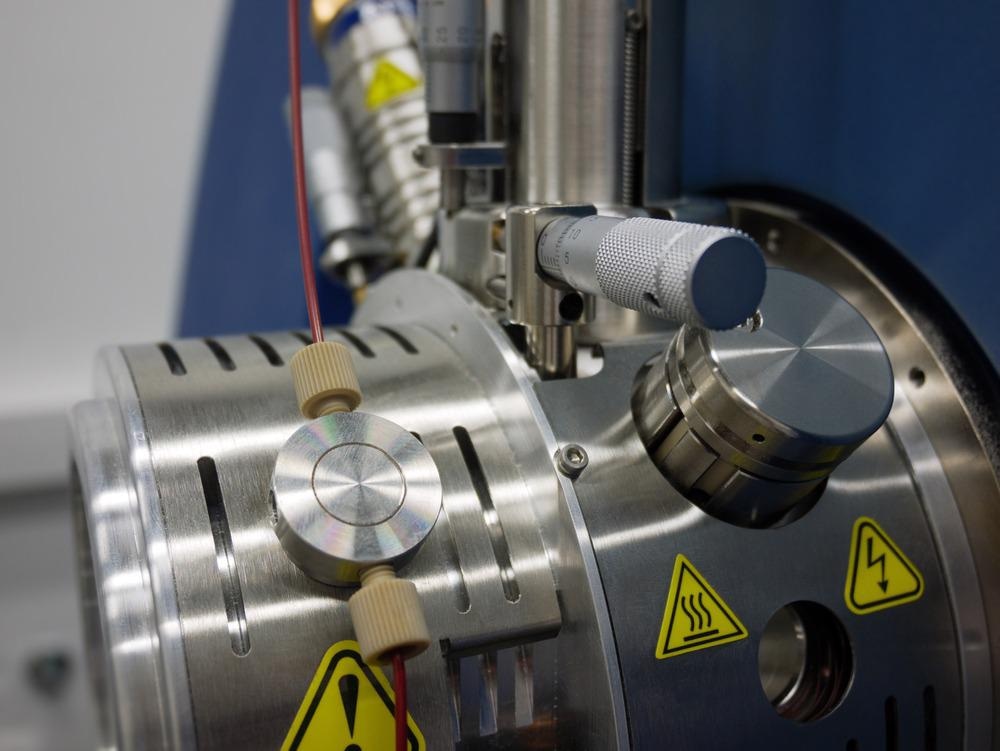Gas mass spectrometry has applications in medicine, environmental monitoring, chemical engineering, astrochemistry, food and beverage development, and professional sports. This article looks at the history of mass spectrometry and gas chromatography mass spectrometry, and shows how the technique is used today.

Image Credit: ShowMeHowToFly/Shutterstock.com
How a Mass Spectrometer Works
Mass spectrometry (MS) is used in several fields today, applied to pure samples and complex concoctions of different elements. The technique measures ions’ mass-to-charge ratio in a sample, which may be liquid, solid, or gaseous. A resulting mass spectrum plots the intensity of the ion signal as a function of the mass-to-charge ratio.
Mass spectra can determine the isotopic signature of a sample (its elemental fingerprint), the masses of different particles and molecules present in the sample, and the structure of molecules and other chemical compounds in the sample (its chemical identity).
The sample is first ionized, for example with an electron beam. This makes some molecules break loose from the sample and into positively charged fragments, or just positively charged particles.
Ions are deflected by a magnetic field
The positively charged ions are separated according to their mass-to-charge ratios. Accelerating the positive ions and applying an electric or magnetic field causes ions of different mass-to-charge ratios to deflect from their acceleration lines in different arcs.
A sensor that detects charge particles, such as an electron multiplier, detects the ions and records their deflected arcs. This data is displayed as a spectrum of the signal intensity of the detected ions, as a function of the mass-to-charge ratio.
For example, known masses (an entire molecule) can correlate the identity of atoms or molecules in the sample by comparing the spectrum with characteristic fragmentation patterns of the known material.
The Role of Gas Analysis in the History of Mass Spectrometry
The history of MS is coupled with the history of gas analysis. Eugen Goldstein first observed rays in gas discharging under low pressure traveling away from the anode in a perforated cathode in 1886. He called the positively charged anode rays Kanalstrahlen, or canal rays.
Wilhelm Wien later discovered that these canal rays were deflected by strong electric or magnetic fields. He created a device with perpendicular electric and magnetic fields in 1899 and successfully separated positive rays according to their charge-to-mass ratio. He found that the charge-to-mass ratio depended on the type of gas used in the discharge tube.
J. J. Thompson rounded off the early discovery of canal tubes and their sensitivity to electromagnetic radiation a few years later when he reduced pressure in the discharge tubes used by Wien to build the world’s first mass spectrograph. Arthur Jeffrey Dempster developed modern techniques in 1918 and F. W. Aston in 1918.
Gas Chromatography Mass Spectrometry
Gas analysis combines a mass spectrometer or mass analyzer with gas chromatography. This technique, gas chromatography MS or GC-MS, was first reported in 1959.
GC-MS is used in fire investigation, environmental analysis, unknown sample identification, and astrochemistry. It is favored because it can detect and measure trace amounts of a substance in a varied and complex gas sample.
GC-MS is regarded as the gold standard for identifying substances forensically. This is because it is a 100% specific test that can positively identify a particular substance, even in tiny, trace amounts. This is opposed to non-specific tests, which only indicate that any of several substances in a certain category may be present in a sample.
GC-MS risks no false positives in terms of identification. However, it is not without its drawbacks. Chief among these is the high temperature in the injection port and oven (typically as much as 300 °C). That can lead to measuring molecules formed after thermal degradation in the sample.
Applications for Gas Chromatography Mass Spectrometry
Medicine
GC-MS is used in medicine to conduct screening tests for newborn babies. These tests can identify signs of congenital metabolic diseases early on and help doctors make effective treatments. With GC-MS, newborn babies can be tested for over 100 known genetic metabolic disorders at birth.
Environmental monitoring and clean up
GC-MS is the preferred method for tracing pollution in the atmosphere. This preference is spurred by a decreasing cost for GC-MS equipment over recent years, coupled with its increasing reliability.
Chemical engineering
In chemical engineering, GC-MS is used to analyze unknown organic compound mixtures. Critically, it has been used to find out what bio-oils obtained from raw biomass were composed of.
Astrochemistry
Two GC-MS devices have visited Mars as part of the Viking missions. Pioneer Venus used a GC-MS device to characterize the atmosphere of Venus. A GC-MS device has even landed on Saturn’s largest moon, Titan, as part of the Huygens probe in the Cassini-Huygens mission.
Sports anti-doping analysis
GC-MS is also the primary technique anti-doping agencies use to test athletes’ urine samples in laboratories. With certainty, GC-MS can detect trace amounts of performance-enhancing drugs such as anabolic steroids.
References and Further Reading
Downard, K. M. (2007). Francis William Aston: The Man Behind the Mass Spectrograph. European Journal of Mass Spectrometry. https://doi.org/10.1255/ejms.878
Fang, M. et al. (2015). Thermal Degradation of Small Molecules: A Global Metabolomic Investigation. Analytical Chemistry. https://doi.org/10.1021/acs.analchem.5b03003
Gas Chromatography-Mass Spectrometry. (2019) American Chemical Society. Available at: https://www.acs.org/content/acs/en/education/whatischemistry/landmarks/gas-chromatography-mass-spectrometry.html
Hites, R. A. (2016). Development of Gas Chromatographic Mass Spectrometry. Analytical Chemistry. https://doi.org/10.1021/acs.analchem.6b01628
Disclaimer: The views expressed here are those of the author expressed in their private capacity and do not necessarily represent the views of AZoM.com Limited T/A AZoNetwork the owner and operator of this website. This disclaimer forms part of the Terms and conditions of use of this website.